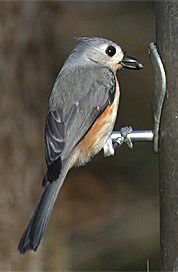Last winter at Hilton Pond Center we had a great many Purple Finches, banding a record 1,063 individuals between 5 December 2003 and 2 March 2004. This year we've entertained oodles of American Goldfinches--303 banded since 1 January--so we thought we might be on pace for a new high for that species.  However, this week the weather turned nice for a few days and the goldfinches virtually disappeared, making us feel a little foolish for having bought a 25-pound bag of thistle seed that may go uneaten. Interestingly, at the same time the goldfinches quit thronging the feeders we had a sudden influx of Song Sparrows--what John James Audubon (his rendering at left) referred to as the "Song Finch." For some folks in the Carolina Piedmont and elsewhere, the appearance of Song Sparrows might not be all that significant, but after banding only one all winter, we captured FOUR on 8 March--and they were what you might call "right on time." However, this week the weather turned nice for a few days and the goldfinches virtually disappeared, making us feel a little foolish for having bought a 25-pound bag of thistle seed that may go uneaten. Interestingly, at the same time the goldfinches quit thronging the feeders we had a sudden influx of Song Sparrows--what John James Audubon (his rendering at left) referred to as the "Song Finch." For some folks in the Carolina Piedmont and elsewhere, the appearance of Song Sparrows might not be all that significant, but after banding only one all winter, we captured FOUR on 8 March--and they were what you might call "right on time."
Although Song Sparrows breed commonly in northwestern South Carolina--even in the eastern section of our home county of York--there appears to be a pocket in central and western York County in which Song Sparrows only appear briefly in autumn and then again in late winter or early spring. Hilton Pond Center lies in the middle of that pocket. Within a few weeks we'll be able to drive 15 miles east to Rock Hill or about that far north into Gaston County NC and hear males singing, but by then they'll likely be gone from Hilton Pond, where we refer to Song Sparrows as our "silent spring songsters."
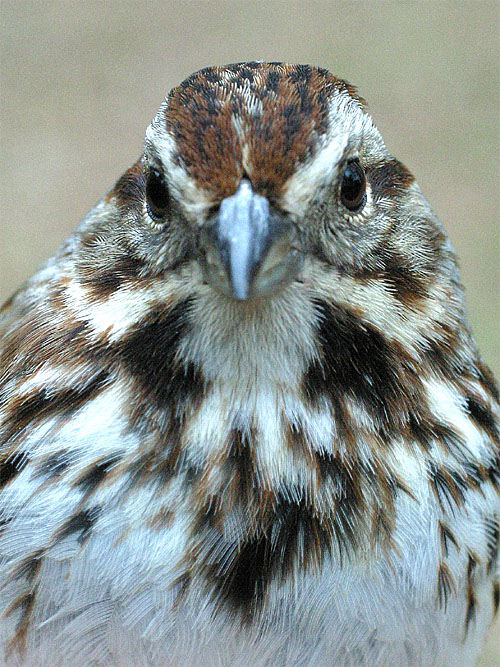
All text & photos © Hilton Pond Center
Of all the eastern sparrows--which birders sometimes refer to as LBJs ("Little Brown Jobbers") because they're similar in appearance and sometimes hard to identify--the Song Sparrow is one of the most distinctive. Diagnostic are its grayish-white supercilliary eye line (above); wide brown line through the eye; dark-topped conical bill; basically brown back, head, wings, and tail; and white breast marked with heavy brown streaks that merge into a central dark spot. Because of these markings, the Song Sparrow often becomes one of the first LBJs that beginning birders identify with confidence. That said, we should mention there is significant geographic difference among Song Sparrows--the species breeds primarily across the northern half of the contiguous U.S. and well into Canada and southern Alaska--and these races or subspecies vary from tannish- or grayish-brown to near-chocolate. Incidentally, Song Sparrows seem to have been expanding their range southward and eastward in the Carolinas in recent decades, so perhaps their relative absence in York County and at Hilton Pond simply means they haven't quite gotten here yet.
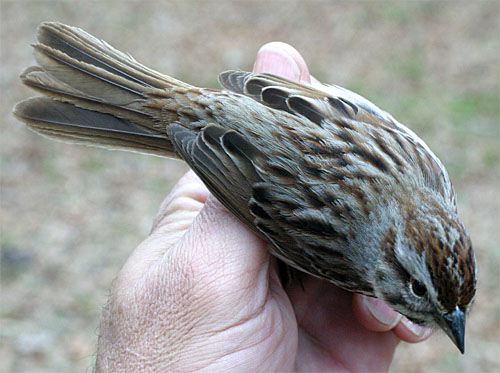
A dorsal view (above) shows that--like most eastern U.S. sparrows--the Song Sparrow has a heavily streaked back. It has a somewhat grayish rump, although streaks also occur on feathers in that area. The wings are unbarred and barely reach to the base of the tail.

Indeed, the Song Sparrow's wings are short and rounded--all the better to flit around in tall grasses and shrubby vegetation. They're also slightly cupped, which appears to be an adaptation that allows the wing to catch more air and provide a more powerful downstroke. 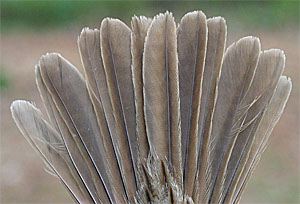 The tail (below right) is relatively long, has no spots or barring, and is more or less rounded; even the individual rectrices (tail feathers) have rounded tips--especially in older birds; those illustrated here are somewhat worn. Song Sparrows typically pump their tails in flight--a good behavioral characteristic that helps with field identification. The tail (below right) is relatively long, has no spots or barring, and is more or less rounded; even the individual rectrices (tail feathers) have rounded tips--especially in older birds; those illustrated here are somewhat worn. Song Sparrows typically pump their tails in flight--a good behavioral characteristic that helps with field identification.
A closer look at the top of the Song Sparrow's head (below left) shows that the crown is not uniformly brown. Instead there is a central gray streak that starts at the base of the bill and widens until it blends in with the gray feathers of the nape.  Together, all these field marks should help a novice birder trying to identify the Song Sparrow, but in spring a dependable characteristic is the bird's musical song. Even the Song Sparrow's scientific name--Melospiza melodia--refers to the species' pleasant vocalization, a so-called "lively" and variable song of many short notes that always ends in a trill. We did rarely hear this song in the late 1980s around Hilton Pond, but because the species prefers shrubby areas and hedgerows, natural succession into young woodland over the past 15 years has undoubtedly made the Center's property less attractive to Song Sparrows. Together, all these field marks should help a novice birder trying to identify the Song Sparrow, but in spring a dependable characteristic is the bird's musical song. Even the Song Sparrow's scientific name--Melospiza melodia--refers to the species' pleasant vocalization, a so-called "lively" and variable song of many short notes that always ends in a trill. We did rarely hear this song in the late 1980s around Hilton Pond, but because the species prefers shrubby areas and hedgerows, natural succession into young woodland over the past 15 years has undoubtedly made the Center's property less attractive to Song Sparrows.
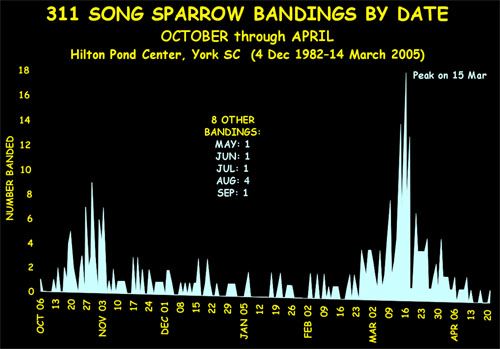
Click HERE for a larger view of the chart
We still get a noticeable bunch of Song Sparrows each autumn with peak arrival during the last week in October, as shown by a chart (above) that summarizes our winter banding results since 1982. Then we usually catch a few from November through February, but the big numbers almost always occur in March with a major influx starting--as it did this week--on about the 8th and continuing until the end of the month. It's apparent these Song Sparrows are following some sort of schedule that--if we were to hazard a guess--is tied to photoperiod and day-length. What we DON'T know is whether these Song Sparrows that suddenly show up in March are moving through from further south or whether they've been in the neighborhood all along and get a sudden hankering for white millet and cracked corn at our feeders. Regardless, it is still amazing--especially after we start analyzing our 24 years of Hilton Pond banding data--just how predictable the arrival of Song Sparrows really is.
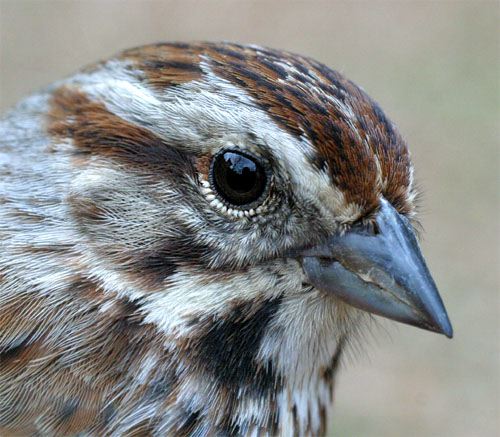
Although we can reliably depend on Song Sparrows in late October and mid-March at Hilton Pond Center, we almost never capture them in late spring, mid-summer, or early fall. As shown on the chart, we DID capture one bird in May and another in September, but these may just have been late and early migrants, respectively. The six birds in June 1995, July 1988, and August 1993 are of real interest, however, because ALL were recent fledglings that undoubtedly hatched out on or near the property. Perhaps these were offspring of parents trying to fill in this Song Sparrow "breeding hole" in western York County, but we don't expect to see their likes at Hilton Pond again. The most recent of those fledglings appeared ten years ago, so we conclude that the current lack of appropriate breeding habitat at the Center probably IS the major reason why Song Sparrows occur here in winter but continue to be the "silent spring songsters" of Hilton Pond.
All text & photos © Hilton Pond Center
Comments or questions about this week's installment?
Please send an E-mail message to INFO.
NOTE: Be sure to scroll down for an account of all birds banded or recaptured during the week, as well as some other interesting nature notes.
"This Week at Hilton Pond" is written & photographed
by Bill Hilton Jr., executive director of
Hilton Pond Center for Piedmont Natural History.
You may wish to consult our Index of all nature topics covered since February 2000. You can also use the on-line Search Engine at the bottom of this page.
For a free, non-fattening, on-line subscription to "This Week at Hilton Pond," just send us an E-mail with SUBSCRIBE in the Subject line. Please be sure to configure your spam filter to accept E-mails from hiltonpond.org.
|

 However, this week the weather turned nice for a few days and the goldfinches virtually disappeared, making us feel a little foolish for having bought a 25-pound bag of thistle seed that may go uneaten. Interestingly, at the same time the goldfinches quit thronging the feeders we had a sudden influx of Song Sparrows--what John James Audubon (his rendering at left) referred to as the "Song Finch." For some folks in the Carolina Piedmont and elsewhere, the appearance of Song Sparrows might not be all that significant, but after banding only one all winter, we captured FOUR on 8 March--and they were what you might call "right on time."
However, this week the weather turned nice for a few days and the goldfinches virtually disappeared, making us feel a little foolish for having bought a 25-pound bag of thistle seed that may go uneaten. Interestingly, at the same time the goldfinches quit thronging the feeders we had a sudden influx of Song Sparrows--what John James Audubon (his rendering at left) referred to as the "Song Finch." For some folks in the Carolina Piedmont and elsewhere, the appearance of Song Sparrows might not be all that significant, but after banding only one all winter, we captured FOUR on 8 March--and they were what you might call "right on time."


 The tail (below right) is relatively long, has no spots or barring, and is more or less rounded; even the individual rectrices (tail feathers) have rounded tips--especially in older birds; those illustrated here are somewhat worn. Song Sparrows typically pump their tails in flight--a good behavioral characteristic that helps with field identification.
The tail (below right) is relatively long, has no spots or barring, and is more or less rounded; even the individual rectrices (tail feathers) have rounded tips--especially in older birds; those illustrated here are somewhat worn. Song Sparrows typically pump their tails in flight--a good behavioral characteristic that helps with field identification. Together, all these field marks should help a novice birder trying to identify the Song Sparrow, but in spring a dependable characteristic is the bird's musical song. Even the Song Sparrow's scientific name--Melospiza melodia--refers to the species' pleasant vocalization, a so-called "lively" and variable song of many short notes that always ends in a trill. We did rarely hear this song in the late 1980s around Hilton Pond, but because the species prefers shrubby areas and hedgerows, natural succession into young woodland over the past 15 years has undoubtedly made the Center's property less attractive to Song Sparrows.
Together, all these field marks should help a novice birder trying to identify the Song Sparrow, but in spring a dependable characteristic is the bird's musical song. Even the Song Sparrow's scientific name--Melospiza melodia--refers to the species' pleasant vocalization, a so-called "lively" and variable song of many short notes that always ends in a trill. We did rarely hear this song in the late 1980s around Hilton Pond, but because the species prefers shrubby areas and hedgerows, natural succession into young woodland over the past 15 years has undoubtedly made the Center's property less attractive to Song Sparrows.



 Oct 15 to Mar 15
Oct 15 to Mar 15